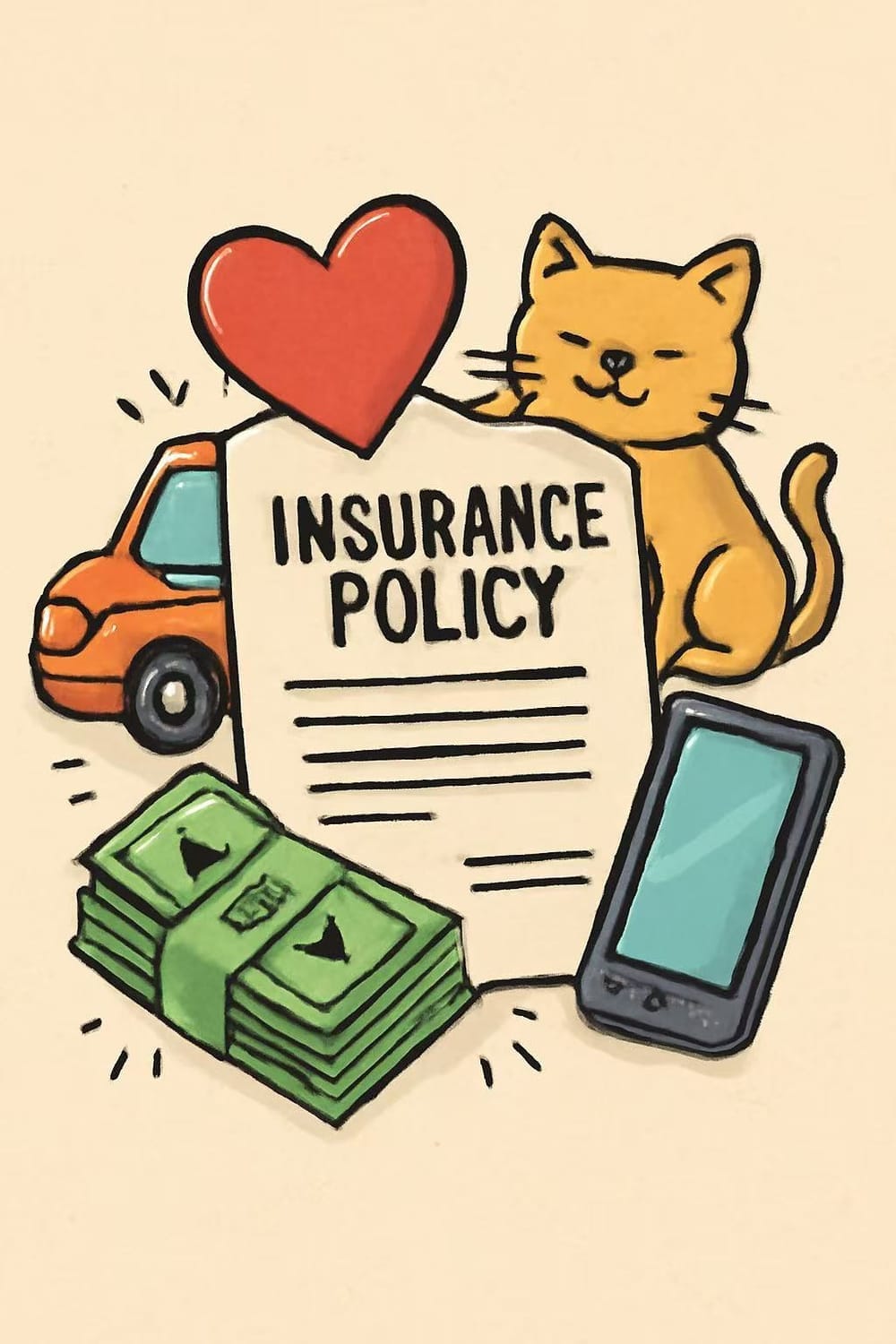
Insurance Explained: How Much Do You Really Need?
Insurance—it feels like buying peace of mind. You pay a little regularly now, so you don’t have to worry about a big financial hit if life throws you a curveball later. But how much insurance do you actually need? And how do you avoid paying for coverage that just drains your wallet?
Let’s face it—insurance can be confusing. Life insurance, health insurance, car insurance… everyone says, “You need this!” But what’s really essential, and what’s just marketing hype? This blog breaks it all down with clear examples, calculations, and a handy checklist to help you decide what fits your life and your budget.
What Is Insurance, Really?
Think of insurance as a safety net. You pay a fee (called a premium) to an insurance company regularly. In return, if something bad happens—like an accident or illness—the insurer helps cover the costs, saving you from a big financial hit.
But not all risks are the same, and neither are insurance policies. For example, if you’re worried about hospital bills, health insurance covers that. If your phone breaks, phone insurance covers that—but not your hospital bills. The key is knowing which risks you face and choosing policies that protect against those.
Life Insurance: Do You Really Need It?
Life insurance pays your loved ones a sum of money if you pass away, helping them cover expenses like living costs, debts, or education.
When Life Insurance Is a Must
Imagine Sarah, a 35-year-old mother in the U.S. with two kids and a mortgage. If Sarah passes away unexpectedly, her family could struggle to pay the bills and maintain their lifestyle. Life insurance here is essential.
When You Might Skip It
Now take James, a 28-year-old single guy with no dependents and no major debts. Life insurance probably isn’t a priority for him yet.
Types of Life Insurance
• Term Life: Covers you for a set period, like 20 years. Affordable, straightforward. Great if you want protection while kids are growing or loans are active.
• Whole Life: Lasts your entire life and includes a savings component. More expensive and complex.
Sample Calculation: How Much Life Insurance Do You Need?
Let’s say you’re John, a 35-year-old living in the U.S., with the following financial picture:
1. Outstanding debts (mortgage, car loans, credit cards): $250,000
2. Living expenses for your dependents for 5 years:
• Monthly expenses: $4,000
• 5 years × 12 months × $4,000 = $240,000
3. Future costs (like college tuition for kids): $100,000
Total insurance coverage needed:
$250,000 (debts) + $240,000 (living expenses) + $100,000 (future costs) = $590,000
John should look for a life insurance policy with at least $590,000 coverage to ensure his family’s financial security if anything happens to him.
Health Insurance: A Must-Have
Hospital bills can be expensive, especially in private healthcare in the U.S. Public hospitals are available, but many people choose private care for faster and specialized services—and that can be costly without insurance.
What to Look For
• Hospitalization: Room and board during a hospital stay
• Surgery: Cost of operations
• Specialist visits: Coverage for specialists
• Pre-existing conditions: Know if your plan covers these or requires waiting
• Exclusions: Avoid plans loaded with exclusions
Real-Life Example
Linda, a U.S. resident, needed surgery after a minor accident. Without insurance, her private hospital bill was $20,000. With health insurance, she only paid $2,000 out-of-pocket, saving her $18,000.
Personal Accident Insurance: Your Extra Safety Net
Personal accident insurance covers injury, disability, or death from accidents—different from health insurance. It’s usually cheaper and pays out a lump sum or monthly payments if you’re disabled.
• Example: Josh, a motorcyclist in the U.S., got into an accident and was unable to work for 3 months. His personal accident insurance paid monthly benefits, helping him cover expenses during recovery.

Car Insurance: Legal and Logical
Driving without insurance is illegal and risky in all 50 states. You need at least third-party insurance to cover damages or injuries to others if you cause an accident.
Comprehensive Coverage
If you want to protect your own vehicle too, comprehensive insurance is worth it. It covers theft, fire, flood, and accidental damage.
Add-Ons
Consider add-ons only if they’re relevant:
• Flood protection if you live in a flood-prone area
• Windshield cover if you live somewhere with lots of road debris
• Roadside assistance if you want peace of mind for breakdowns
How Much Should You Pay?
A general rule of thumb: Keep your insurance premiums under 10% of your income.
Tips to Avoid Overpaying
• Compare plans yearly. Even spending 15 minutes on a comparison website can save you hundreds.
• Don’t renew old policies without review—your needs change!
• Bundling policies can reduce total costs.
How to Choose the Right Plan for You
Ask yourself:
• Do I travel often? Maybe get travel insurance.
• Am I healthy or managing a condition? That affects premiums and coverage.
• What’s my budget?
Balance coverage and cost—too little coverage risks huge bills; too much drains your wallet.
Insurance You Can Skip (Sometimes)
• Pet insurance if you don’t have pets.
• Phone insurance—often cheaper just to protect your phone with a case.
• Flight insurance—often included in credit card benefits or travel bookings.
Quick Checklist: What Insurance Do You Need?
Insurance Type Life Insurance
Do You Need It If… You have dependents or debts
Notes Calculate coverage based on needs
Insurance Type Health Insurance
Do You Need It If… You want private hospital access or have medical costs
Notes Check for exclusions
Insurance Type Personal Accident
Do You Need It If… You want extra coverage for accidents
Notes Great supplement to health insurance
Insurance Type Car Insurance
Do You Need It If… You drive a vehicle
Notes At least third-party, ideally comprehensive
Insurance Type Travel Insurance
Do You Need It If…. You travel frequently
Notes Check if already covered by credit cards
Insurance Type Pet Insurance
Do You Need It If… You have expensive pets
Notes Only if vet bills are a concern
Insurance Type Phone Insurance
Do You Need It If… Your phone is very expensive and prone to damage
Notes Often unnecessary if careful
Final Thoughts
Insurance doesn’t have to be confusing. Focus on what applies to you and your loved ones. Calculate what you need, compare plans, and avoid unnecessary add-ons.
By investing wisely in insurance, you’re not just protecting yourself—you’re buying peace of mind that lets you live confidently, knowing you’re covered if life throws a curveball.
If this post helped clear up your insurance questions, stay tuned for more smart money tips! Your wallet will thank you.
💸 Paying too much for insurance? Discover the insider tips that helped me cut my premiums without losing coverage — it's easier than you think!
🎥 Watch the video 👉 https://youtu.be/ec4x7J3c9XY?si=c9MC9Tsqs4gRSIda
👍 Like this video? Smash the like button, subscribe for more money-saving hacks, and hit the bell so you never miss an update!

HEY, I’M AUTHOR…
Emily C is the visionary behind Dream Pay Blueprint, a blog dedicated to empowering individuals to create sustainable passive income and achieve financial freedom. With a passion for simplifying complex money matters, she shares actionable strategies, proven side hustles, and practical financial advice tailored to modern lifestyles.
When not writing, she loves exploring innovative income opportunities, connecting with readers, and inspiring people to turn their dreams into reality. Follow along for tips to build your blueprint for success!
JOIN MY MAILING LIST

Welcome to Dream Pay Blueprint — your guide to turning passion into profit. We’re here to help you build side hustles, earn passive income, and achieve financial freedom with practical, beginner-friendly strategies.
Newsletter
Subscribe now to get daily updates.
Created with © systeme.io


